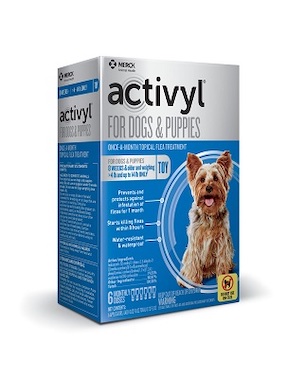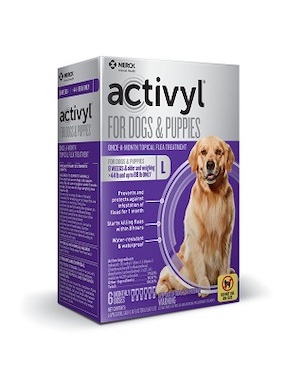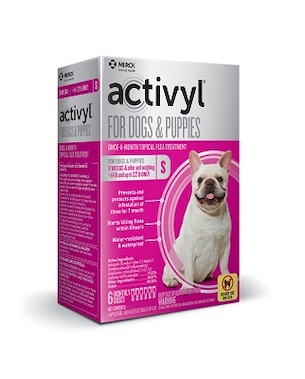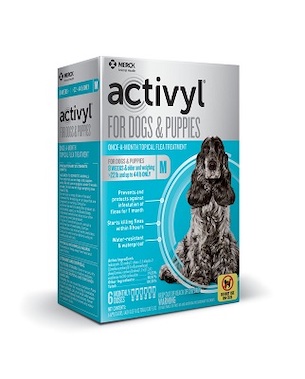ACTIVYL® FOR DOGS AND PUPPIES

Activyl is a monthly spot-on flea control for dogs. The active ingredient in Activyl is indoxacarb, which works by bioactivation – enzymes inside the flea activate indoxacarb and release its full flea-killing power. There is no known flea resistance to indoxacarb. Activyl stops fleas from feeding, kills all flea stages (egg, larvae and adult), and inhibits flea development in the environment.
What makes Activyl flea treatment different?
Activyl contains indoxacarb, which was specifically developed to overcome insect resistance in crop protection. Indoxacarb is a pro-insecticidal compound that requires enzymatic activation in the flea where it is converted into its highly potent insecticidal form. Activyl is metabolized differently in insects than in mammals. Unlike insects, mammals mostly metabolize indoxacarb into nontoxic metabolites.
Why Activyl?
- It contains indoxacarb, an active ingredient never before used for flea control, and features bioactivation–a mode of action that uses enzymes inside the flea to activate Activyl’s full flea-killing power.
- It is effective at killing adult and developing stages of fleas and there is no known resistance.
- It delivers 4 weeks of efficacy against adult fleas on the pet and developing stages of fleas in the pet’s environment.1
- It is well tolerated by dogs and puppies.
- It is approved for use on dogs and puppies over 4 lb from 8 weeks of age.1
- It is waterproof and remains effective after shampooing and bathing.1
- It remains effective after exposure to sunlight.1
Product Labels
- Activyl Spot-On for Dogs and Puppies (over 4 lb and up to 14 lb)
- Activyl Spot-On for Dogs and Puppies (over 14 lb and up to 22 lb)
- Activyl Spot-On for Dogs and Puppies (over 22 lb and up to 44 lb)
- Activyl Spot-On for Dogs and Puppies (over 44 lb and up to 88 lb)
- Activyl Spot-On for Dogs and Puppies (over 88 lb and up to 132 lb)
1. Data on file, Merck Animal Health.
What is Bioactivation?
Activyl contains a highly efficacious agent: indoxacarb. Activyl is unique because indoxacarb was designed as a pro-insecticide–that requires biological or metabolic activation, also known as “bioactivation”, in susceptible insects to convert it to its highly insecticidal form–thus enhancing its selective toxicity.1 In addition, indoxacarb works at a site of action in the flea different from other commercialized insecticides used for flea control. The indoxacarb in Activyl is bioactivated in the flea by enzymatic N-decarbomethoxylation changing it to a more active, highly insecticidal metabolite.1
- Insect esterase enzymes cleave the carbomethoxyl group from the urea linkage
- Yields an active, highly insecticidal metabolite
- Pharmacological action in insects
- Potent and rapid voltage dependent sodium ion channel blocker.2
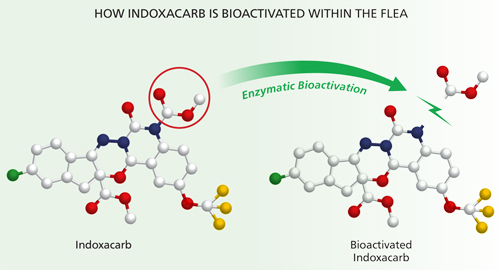
A unique mode of action
This enzymatic cleavage occurs in insects but not mammals. Mammals metabolize indoxacarb differently, mostly to non-toxic metabolites. In addition, compared to insects, mammalian sodium channels are significantly less sensitive to bioactivated indoxacarb.
Activyl provides selective toxicity through:
- High rate of biological activation in susceptible insects
- Differential sensitivity of sodium ion channels between insects and mammals: significantly lower concentrations are effective in insects.3
- Alternative metabolic pathways (indanone and oxadiazine ring cleavage) in mammals convert indoxacarb mainly to non-toxic metabolites.3, 4
- Relatively minor biological activation in mammals. 3, 4
Indoxacarb produces its potent effects at a unique binding site in voltage-gated sodium ion channels of the nervous system of susceptible insects.4 This effect differs strikingly from those reported for other insecticides such as pyrethroids, also known to affect the voltage-dependant sodium channels, but at a different site.1, 2, 4
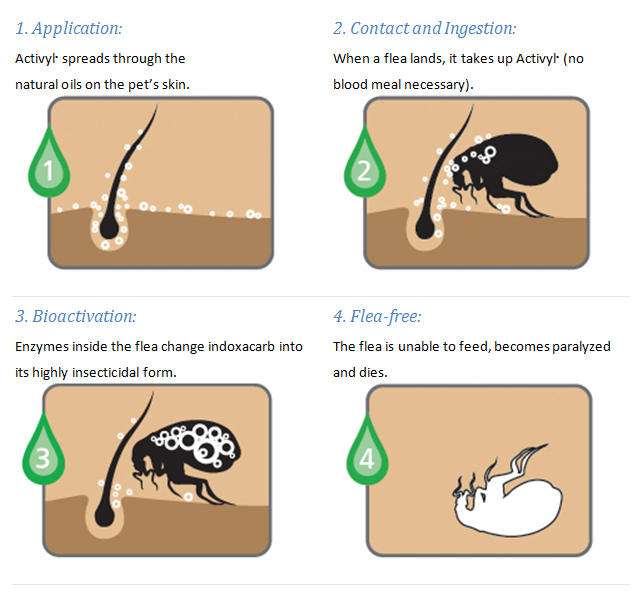
The active metabolite of indoxacarb induces irreversible hyperpolarization of insect nerve cell membranes. It blocks the sodium current amplitude in the neuron differently than the pyrethroids. This results in impaired insect nerve function, feeding cessation, paralysis and death of susceptible insects.
Effective against immature flea stages and thereby breaking the flea life cycle
Activyl rapidly affects adult fleas following contact or ingestion resulting first in cessation of flea feeding and then causing flea paralysis and death. Controlled tests show that 90% of adult fleas are killed within 12 hours of application and newly arriving fleas are killed within 8-12 hours for a full month.
Activyl also kills developing stages of fleas in the environment of treated dogs and cats, meaning that these stages cannot develop into biting adult fleas.
A single treatment with Activyl inhibits the development of immature fleas exposed to debris from treated animals by more than 90% for at least 4 weeks.5 This is reflected in the dramatic decrease in household infestation following treatment with Activyl.
Since more than just adult fleas are affected, pets get relief and the flea life cycle in the environment is also inhibited, rapidly solving the many stages of your client’s flea problem.
References:
- Wing KD, Sacher M, Kagaya Y, Tsurubuchi Y, Mulderig L, Connair M, Schnee M. Crop Protection. 2000;19:537-545.
- Lapied B, Grolleau F, Sattelle DB. Br J Pharmacol. 2001;132:587-595.
- Zhao X, Ikeda T, Yeh JZ, Narahashi Y. Neurotoxicology 2003;24:83–96.
- Dong K. Insect sodium channels and insecticide resistance. InvertNeurosci. 2007;7:17–30.
- Data on file, Merck Animal Health.

